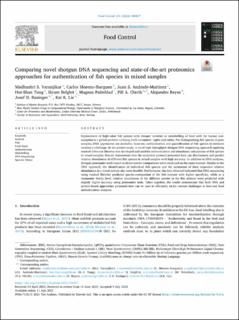Comparing novel shotgun DNA sequencing and state-of-the-art proteomics approaches for authentication of fish species in mixed samples
Varunjikar, Madhushri S.; Moreno-Ibarguen, Carlos; Andrade-Martinez, Juan S.; Tung, Hui-Shan; Belghit, Ikram; Palmblad, Magnus; Olsvik, Pål Asgeir; Reyes, Alejandro; Rasinger, Josef; Lie, Kai Kristoffer
Others
Published version
Permanent lenke
https://hdl.handle.net/11250/2837804Utgivelsesdato
2021Metadata
Vis full innførselSamlinger
- Articles [3012]
- Publikasjoner fra CRIStin [3070]
Originalversjon
10.1016/j.foodcont.2021.108417Sammendrag
Replacement of high-value fish species with cheaper varieties or mislabelling of food unfit for human consumption is a global problem violating both consumers’ rights and safety. For distinguishing fish species in pure samples, DNA approaches are available; however, authentication and quantification of fish species in mixtures remains a challenge. In the present study, a novel high-throughput shotgun DNA sequencing approach applying masked reference libraries was developed and used for authentication and abundance calculations of fish species in mixed samples. Results demonstrate that the analytical protocol presented here can discriminate and predict relative abundances of different fish species in mixed samples with high accuracy. In addition to DNA analyses, shotgun proteomics tools based on direct spectra comparisons were employed on the same mixture. Similar to the DNA approach, the identification of individual fish species and the estimation of their respective relative abundances in a mixed sample also were feasible. Furthermore, the data obtained indicated that DNA sequencing using masked libraries predicted species-composition of the fish mixture with higher specificity, while at a taxonomic family level, relative abundances of the different species in the fish mixture were predicted with slightly higher accuracy using proteomics tools. Taken together, the results demonstrate that both DNA and protein-based approaches presented here can be used to efficiently tackle current challenges in feed and food authentication analyses.
